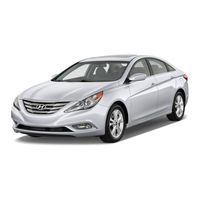Hyundai Sonata 2014 Midsize Sedan Car Manuals
Manuals and User Guides for Hyundai Sonata 2014 Midsize Sedan Car. We have 1 Hyundai Sonata 2014 Midsize Sedan Car manual available for free PDF download: Owner's Manual
Hyundai Sonata 2014 Owner's Manual (381 pages)
Operation
Maintenance
Specifications
Brand: Hyundai
|
Category: Automobile
|
Size: 6 MB
Table of Contents
-
-
Rear Seat19
-
Seats19
-
Front Seat21
-
Headrest24
-
Armrest30
-
Seat Belts34
-
SRS Care78
-
-
-
Keys83
-
Glove Box84
-
Lock84
-
Lock Release84
-
Locking87
-
Unlocking88
-
Panic89
-
Start-Up89
-
Armed Stage94
-
Door Locks98
-
Windows104
-
Power Windows105
-
Closing the Hood108
-
Opening the Hood108
-
Sunshade114
-
Steering Wheel115
-
Horn116
-
Tilt Steering116
-
Mirrors117
-
Compass Function119
-
Remote Control124
-
Switch124
-
Switch127
-
Tachometer127
-
Fuel Gauge129
-
Trip Computer129
-
Elapsed Time132
-
Vehicle Setting133
-
Auto Door Lock133
-
Auto Door Unlock133
-
Headlamp Delay134
-
ECO Indicator135
-
Low Key Battery144
-
Insert Key145
-
Shift to "P"145
-
Remove Key145
-
Low Washer Fluid147
-
Lighting148
-
Lighting Control149
-
Interior Light155
-
Map Lamp155
-
Glove Box Lamp156
-
Trunk Lamp156
-
Room Lamp156
-
Defroster158
-
Mode Selection161
-
Air Conditioning164
-
Heating165
-
Ventilation165
-
System Operation165
-
Defrost-Level171
-
OFF Mode174
-
Defogging Logic177
-
Sunglass Holder179
-
Multi Box179
-
Sunvisor180
-
Cup Holder180
-
Power Outlet181
-
Audio System184
-
Antenna184
-
FM Reception185
-
FM Radio Station186
-
MIDDLE Control192
-
TREBLE Control192
-
FADER Control192
-
BALANCE Control192
-
Cdp(Pa710Yf)193
-
Menu Tree211
-
Phone Setup212
-
Pairing Phone212
-
Connecting Phone213
-
Deleting Phone213
-
Calling by Name215
-
-
Before Driving219
-
Before Starting219
-
Key220
-
ACC (Accessory)221
-
Start221
-
Downshifting228
-
Using the Clutch228
-
Transaxle Ranges231
-
Sports Mode233
-
Brake System237
-
Power Brakes237
-
Parking Brake238
-
Parking Brake*239
-
ESC off Button243
-
ESC on Condition243
-
ESC Operation243
-
When Operating243
-
-
Indicator Light244
-
ESC off Usage244
-
Smooth Cornering254
-
Driving at Night254
-
Drive Belt256
-
Tires256
-
Highway Driving256
-
Winter Driving257
-
Snow Tires257
-
Tire Chains258
-
Seating Capacity261
-
Towing Capacity262
-
Cargo Capacity262
-
Vehicle Weight266
-
Base Curb Weight266
-
Cargo Weight266
-
Trailer Towing267
-
-
-
Road Warning269
-
Jump Starting271
-
Push-Starting272
-
Jack and Tools279
-
Changing Tires280
-
Towing Service287
-
-
Maintenance289
-
Fuse Box290
-
Air Cleaner295
-
Engine Coolant311
-
Washer Fluid314
-
Air Cleaner316
-
Wiper Blades319
-
Blade Inspection319
-
Battery321
-
Reset Items323
-
Tires and Wheels324
-
Tire Care324
-
Tire Rotation326
-
Tire Replacement328
-
Tire Traction329
-
Tire Maintenance329
-
Tread Wear332
-
DOT Markings334
-
Curb Weight334
-
All Season Tires335
-
Summer Tires335
-
Radial-Ply Tires336
-
Fuses337
-
Memory Fuse339
-
Multi Fuse340
-
Light Bulbs346
-
Headlight Bulb347
-
Appearance Care352
-
Exterior Care352
-
Waxing353
-
Interior Care356
-
Canister359
-
Dimensions363
-
Bulb Wattage363
-
Engine Number368
-
Index371
-
Spare Tire378
-
Advertisement
